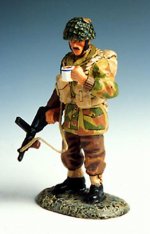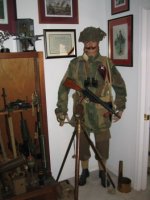Hi Dan,
Unfortunately you have to sign up on the 'Defending Arnhem' web site in order to view and/or download the analysis that I have posted there. However I'm going to provide a synopsis in this post, and if your e-mail address is available will forward the total document (without the map and a couple of pictures). Maybe I will be able to send the entire document, will certainly try. In addition will provide by a separate post on this forum a bibliography published by the British Joint Forces Command and General Staff College.
As a naval intelligence officer and student of military history I became intrigued with the World War II epic action of the British 1st Airborne Division at the Battle of Arnhem, also known as Operation Market-Garden, 17-25 September 1944. I have studied the battle, acquired substantial original source documentation, including Operation Orders and After Action Reports, and toured the actual battlefields in Arnhem, Oosterbeek and adjacent dropping and landing zones at Ginkels and Renkum Heaths, all over a span of nearly forty years. The Battle of Arnhem provides a classic case of the momentum of war, exacerbated by the inordinately extreme egos of the command leadership, exercised in the face of incontrovertible and detailed intelligence and in comprehensive violation of well established, battle-proven strategy, tactics and doctrine.
Montgomery’s and Browning’s apparent combined ignorance of this new type of warfare was only exceeded by their pompous arrogance, recalcitrance and unbelievably engorged egos. It has been stated that if Montgomery had advanced his concept for Market-Garden as a young staff officer attending the Royal Dutch Military Command College, he would have been cashiered out of the course, and very possibly the army. (Single axis of attack and logistics, lack of infantry support of armor, limited maneuver room (single road on raised embankment) and bad trafficability (flat and marshy) for armor, three major rivers and three canal systems (six bridges), length of time before linking up with the airborne elements, to cite but a few fatal flaws.) Admittedly this is a fairly strong indictment of these two leaders, however I believe an overwhelming case can be made based upon an obscure, thin but incisive, official publication of the British Army which was patently ignored and violated by both these high ranking officers.
The document is entitled, AIRBORNE OPERATIONS, Pamphlet No. 1, GENERAL, 1943 (Provisional), May, 1943. Prepared under the direction of The Chief of the Imperial General Staff. In its 49 pages the pamphlet details "considerations" (read battle proven axioms) regarding the planning and execution of airborne operations. The contents of this document were subsequently further codified and discussed in greater detail in a major volume entitled AIRBORNE FORCES, LtCol T.B.H. Otway, DSO, Army Council, HMSO, London, 1951 (Confidential). When the overall strategy and planning for Operation Market-Garden are compared with the contents of the pamphlet, it is as if each one of the fundamental elements was reviewed, then categorically ignored or violated. Only four significant individuals questioned the planning, Crown Prince Bernard of the Netherlands, titular CinC of Dutch Forces in exile, MajGen Stanislaw Sosabowski, OC, 1st Independent Polish Parachute Brigade and Maj Brian Urquhart, Browning's intelligence officer (later Deputy Secretary-General of the United Nations). Each was ignored and/or rebuked, and in Maj Urquhart's case, relieved for alleged "battle fatigue". In addition, and most significantly, LtGen Browning reviewed the plan with MajGen Richard "Windy" Gale, OC, 6th Airborne Division, who had commanded that division during highly successful D-Day operations at Normandy, only a few months earlier. MajGen Gale expressed serious reservations regarding the plans for Operation Market-Garden. LtGen Browning chose to totally ignore his adamant recommendations. It is truly ironic that although not classified. the cover of the pamphlet contains two strongly worded admonitions; NOT TO BE PUBLISHED, The information given in this document is not to be communicated, either directly or indirectly, to the Press or any person not holding an official position in His Majesty's Service and THIS DOCUMENT MUST NOT FALL INTO ENEMY HANDS. Apparently it didn't even fall into the hands it should have, let alone those of the enemy.
Returning to the planning and operational instructions detailed in the pamphlet AIRBORNE OPERATIONS compared with the actual planning for Operation Market-Garden, it should be acknowledged that the errors which were made have been extensively defined and analyzed in several extremely well researched and written books. These include definitive works by eminent authors, Cornelius Ryan, Peter Herclerode, Martin Middlebrook, Max Arthur, Robert J. Kershaw, John Fairley, and Maurice Tugwell, to name just a few. In addition, ranking actual participants, MajGen Roy E. Urquhart, CB, DSO, OC, 1st Airborne Division, MajGen John D. Frost, CB, DSO, MC, OC, 2nd Battalion, The Parachute Regiment, as well as key subordinates, have also authored excellent books. However, to the best of my knowledge, no one to date has specifically cited how every significant part and article of the pamphlet was either categorically ignored or violated. In order to do this in a structured manner the pertinent Part number, subordinate article and sub-article will be cited as they sequentially appear. For those who may not be familiar in detail with the actual planning and execution of the operation, a short statement of the acknowledged historical facts will follow each notation. The entire pamphlet is not reproduced herein, so the reader will have to rely on the integrity and objectivity of the author that all pertinent elements are included, and that in the opinion of the author the omitted text would not provide either opposing or mitigating information.Given the fluidity of the European Theatre of Operations extant in late August of 1944, compounded by the extreme stretch of logistical support confronting the Allied Forces, a great deal of latitude must be afforded the field commanders in the conduct of combat operations at both a tactical and strategic level. The overall concept of Operation Market-Garden was if not brilliant, certainly unique. As regards the planning and execution, it can be said, "the devil was in the details". Unfortunately those details contained in a seemingly obscure pamphlet of the British Army, in the opinion of the author, were categorically ignored and violated. The elements, which appear to have substantially contributed to this disregard, are in nominal ranked order of importance as follows:
• Violation of basic axioms of airborne warfare by senior commanders (specifically multiple lifts versus a single lift thus dividing the mass of the1st Airborne Division, and losing the element of surprise for follow-on elements.)
• The lack of knowledge of the capabilities and limitations of airborne troops, and/or the application of that knowledge, by senior commanders (specifically the selection of DZs and LZs of excessive distance from the division's objective, given its inherent limited mobility. Taken in combination with multiple lifts the two factors produced a compound negative effect.)
• The inordinate egos and inflexibility of senior commanders (this factor permeated the entire planning process)
• The repeated abject rejection of critical intelligence by senior commanders
• Total disregard of advice and counsel from combat proven airborne commanders by senior commanders
• Lack of interoperability between the Airborne Forces and the RAF and USAAF Troop Carrier Commands
• Disregard for the resilience, defensive operational capabilities and tactical improvisation of German Forces by senior commanders
• The momentum of combat operations
Taken in totality the compounded errors were overwhelming, if not synergistic, in guaranteeing failure. It is only at the top that commanders, and as importantly their staffs, can integrate all the requisite elements of victory. When it is achieved it is the commander who receives the laurels; conversely in failure he has to take the mantle of responsibility. In the case of Operation Market-Garden it is my personal opinion that Field Marshal Montgomery and Lieut-General Browning failed on both counts.
As a result of all these factors it was indeed, as LtGen Browning is purported to have commented, perhaps "A Bridge Too Far".
Hopefully this may clarify/justify the attitude expressed in my initial post.
Best regards
Jim Gordon



